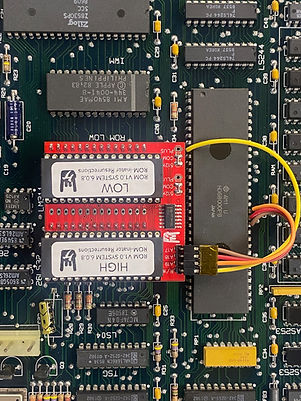
Macintosh Plus
The Mac Plus followed the design of the original Macintosh but let you expand RAM up to 4MB. It was the first Mac to feature a SCSI port for connecting hard drives and a variety of other devices, and it also introduced the ADB port. Compared to the later Mac SE, the only real downside was that it was a bit slower—otherwise, it had no major drawbacks, which helped it stay compatible and become a long-lasting favorite.
Recommended Hardware Mods
Diode installation and BlueSCSI DB25
The Mac Plus can use external SCSI, but the connector doesn’t supply bus-powered +5V out of the box. However, there’s a footprint on the board (CR1) for a diode to provide +5V. You could slap in a regular rectifier like a 1N4001, and it would work, but my personal pick is a Schottky diode—1N5819 (or 5817/5818) works perfectly.
Why Schottky? It has a super low forward voltage drop—around 0.2–0.45V—compared to 0.7V for regular diodes. That means your 5V SCSI line barely loses any voltage, keeping your devices stable. It also protects against reverse current and miswiring, and generates less heat, so your board and peripherals stay happy even during long sessions. Basically, for the Mac Plus SCSI 5V line, a Schottky is the safest, most reliable choice. The 1N5819 is easy to source and handles plenty of voltage, making it the go-to option.
Once you’ve installed the diode, the BlueSCSI DB25 just works. If you’re using the current BlueSCSI V2, you’ll need a special bluescsi.ini file in the SD card root. You could try to integrate the SCSI card inside the Mac itself, but the DB25 is compact—same depth as other connectors—so there’s not much point!
With SCSI working, you get all kinds of perks. BlueSCSI even has a Dynaport Wi-Fi emulation option, letting vintage Macs browse the web at slow speeds. CD-ROMs and other devices can also be emulated, making your setup surprisingly flexible.
ROM-inator
My friend Steve Chamberlin (Founder of BMOW) released a kit called the ROM-inator around 2015, which allows a Mac to boot directly from ROM. Rob Braun and Doug Brown were major contributors as early-stage developers.
What this means is that the original 128 KB Macintosh ROM can be expanded up to 1 MB, and its address mapping hacked to allow ROM booting, similar to a Mac Classic. It’s a really fun modification for early Macs. For a while, production had ended at BMOW, but I was so impressed with this ROM kit that I thought it would be a shame if people couldn’t get it. So I asked Steve Chamberlin to revive the ROM-inator, which had been discontinued at the time, and now I sell it in my store as ROM-inator Resurrections!
*A frequently asked question: the ROM-inator does not support the SCSI card Dove MacSnap.
By using this kit, you can instantly boot a Mac OS without an internal hard drive. Since it doesn’t rely on the built-in floppy drive, you can freely insert and remove floppy disks, without being tied to a specific boot disk.
*For more details, click here
Mac Plus Accelerators – Fun but Not Very Practical
Yes, you can use an accelerator with a Mac Plus. At the moment, Kero’s Mac Mods doesn’t offer any Mac Plus accelerators, but German hardware hacker Bolle reverse-engineered a board, and you can download the Gerber files here. If you’ve ever made a PCB yourself, you can use these files to build your own accelerator.
I actually tried building one myself. The short version: it needs extra power. The Mac Plus’s 5V supply is too weak, so even if the system boots, the accelerator won’t run properly. I ended up tapping a laptop power supply to provide the extra juice. That made it stable, but it produces heat, meaning you can’t run it for long periods and you need proper ventilation.
In the end, building a Mac Plus accelerator is a lot of fun!—but if you’re looking for a truly practical performance boost, it’s probably not worth it.
There was also a very simple accelerator called the Brainstorm. It kept the 68000 CPU but simply doubled the clock speed. Unfortunately, compatibility was poor, and some software would not run correctly (I don’t know the details very well). I actually own one myself, but sadly, it doesn’t work...
Installation required changing a jumper and swapping out a single programmable logic chip. There’s also a film-type capacitor located under the ROM. If you happen to come across a machine that still has this installed, I’d be very grateful if you could share any information with me.
When I first knew the Mac Plus back in its day, models like the SE/30 and the Classic were already around, so my impression of the Plus was that it was painfully slow and difficult to use. Still, some of my friends who didn’t want to spend much money managed to run sequencer software on it. I remember the work being quite a struggle. But like I mentioned at the start, there really aren’t any big downsides, so compared to the compact Macs that came out later, the only thing it’s missing is ADB. And honestly, what we care about most is that the shell case just looks cool!
Japanese users often had a strong preference for localized Japanese OS versions, but musicians at the time were different. They wanted their computers as light as possible, so they only used the English OS, which was faster. In fact, they were practically obsessed with stripping down their machines to the bare minimum lol.






